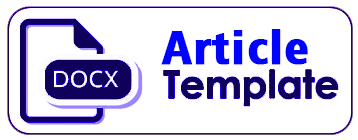IMPLEMENTASI PEMIKIRAN DIGITALISASI DAN FUTURISTIK DALAM PEMBELAJARAN MATEMATIKA DI SD
DOI:
https://doi.org/10.47200/aoej.v14i2.1940Keywords:
Digitalisasi, futuristik, pembelajaran matematika di SDAbstract
The digital era is the division of the economy caused by technological developments that refer to opportunities that impact education. This influence is called digitization in the learning process. The method used is a literature study by reviewing ten articles in national journals and then analyzing them according to the indicators of this study, namely digitization and futuristics. The results showed that (1) Learning is not limited by time and space; (2) Ease of obtaining information not only by teachers and students but also everyonel (3) Education requires learning to follow the development of innovative and creative technology to produce curriculum updates and other learning tools. One example of technological growth in line with futuristic thinking that can apply to mathematics learning in elementary schools is the application of GeoGebra, which can assist students in visualizing the mathematical learning process and tools for teachers in providing geometry to students.
Downloads
References
Al Muchtar. (2001). Pendidikan dan Masalah Sosial Budaya. Gelar Pustaka Mandiri.
ALA (American Library Association). (1989). Presidential Committee on information literacy. Associatio of College and Research Libraries.
Bayram, H., & Comek, A. (2009). Examining the relations between science attitudes, logical thinking ability, information literacy and academic achievement through internet assisted chemistry education. Procedia - Social and Behavioral Sciences, 1(1), 1526–1532.
Daud, A., Aulia, A. F., & Ramayanti, N. (2019). Integrasi teknologi dalam pembelajaran: Upaya untuk beradaptasi dengan tantangan era digital dan revolusi industri 4.0. Unri Conference Series: Community Engagement, 1, 449–455.
Diamandis, P. H., & Kotler, S. (2012). Abundance: The future is better than you think . Free Press.
Dikovich Lj. (2007). An Interactive Learning and Teaching of Linear Algebra byWeb Technologies: Some Examples“, . Journal the Teaching of Mathematics, X(2), 109–116.
Hohenwarter, M., & Preiner, J. (2007). Dynamic Mathematics with GeoGebra. Journal of Online Mathematics and Its Applications, 7(1), 2–12.
Indarta, Y., Jalinus, N., Abdullah, R., & Samala, D. A. (2021). 21st Century Skills: TVET dan Tantangan Abad 21. Edukatif: Jurnal Ilmu Pendidikan, 3(6), 4340–4348.
Kesumaningtyas, S., Anjani, F. D., Yumerda, D., & Nugraha, D. (2022). Pengembangan Media Audio Berbasis Podcast dalam Pembelajaran Digital: Peran dan Kegiatan Ekonomi Masyarakat. Edukatif: Jurnal Ilmu Pendidikan, 4(4), 5331–5341.
Khairunnisa, S., & Aziz, A. T. (2021). Studi Literatur: Digitalisasi Dunia Pendidikan dengan Menggunakan Teknologi Augmented Reality pada Pembelajaran Matematika. Jurnal Riset Pendidikan Matematika, 3(2), 54–63.
Kurniawaty, I., & Hadian, A. V. (2022). Membangun Nalar Kritis di Era Digital. Edukatif: Jurnal Ilmu Pendidikan, 4(3), 2683–3690.
Mahmudah, A. (2009). The analysis of domestic workers protection policy: PRT (domestic worker) raperda making process in Yogyakarta. Graduate School, Gadjah Mada University.
Ogan, C., & Ibibo, G. (2018). GeoGebra: A Technological Soft Ware for Teaching and Learning of Calculus in Nigerian Schools. American Journal of Applied Mathematics and Statistics., 6(3), 115–120.
Rosnaeni, Sukiman, Muzayanati, A., & Pratiwi, Y. (2022). Model-Model Pengembangan Kurikulum di Sekolah. Edukatif: Jurnal Ilmu Pendidikan, 4(1), 467–473.
Sakti, H. R., Jalinus, N., Abdullah, R., Ridwan, & Refdinal. (2022). Filsafat pada Pendidikan Kejuruan yang Mengacu pada Perkembangan Zaman dan Pengalaman pada Negara-Negara Berkembang: Perspektif Teori. Edukatif: Jurnal Ilmu Pendidikan, 4(6), 7497–7502.
Sulistyowati, & Rachman, A. (2017). Pemanfaatan Teknologi 3D Virtual Reality pada Pembelajaran Matematika Tingkat Sekolah Dasar. NERO: Networking Engineering Research Operation, 3(1), 37–43.
Wahyono, P., & Wahyono, P. ,. (2020). Guru profesional di masa pandemi COVID-19: Review implementasi, tantangan, dan solusi pembelajaran daring. Jurnal Pendidikan Profesi Guru, 1(1), 51–65.
Wulandari, R., Santoso, & Ardianti, D. S. (2021). Tantangan Digitalisasi Pendidikan bagi Orang Tua dan Anak di Tengah Pandemi Covid-19 di Desa Bendanpete. Edukatif, 3(6), 3839–3851.
Zikopoulos, P. (2012). Understanding big data: Analytics for enterprise class Hadoop and streaming data. . McGraw-Hill.






